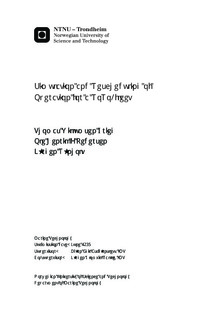| dc.description.abstract | This master thesis is a part of the MARFLIX (MARitime FLeet size and mIX) project. The research project MARFLIX is a collaboration between NTNU, MARINTEK, DNV and WWL. The overall aim for the MARFLIX project is to develop and test methods for improved support for fleet size and mix decision-making through quantitative methods. Wallenius Wilhelmsen Logistics (WWL) is a global liner shipping company which delivers shipping and logistics solutions for manufacturers of car, trucks, heavy equipment and specialized cargo. In this master thesis a framework model that is able to test and verify deployment models was developed. This framework model contains a simulation part and an optimization part. The simulation model is constructed to simulate the day to day operations of a fleet. In the day to day operation disruptions will occur. These disruptions are simulated by the use of two different probability distributions and Monte Carlo Simulation. Disruptions occur regularly in a global liner shipping network. About 70-80 % of the vessels experience delays in at least one port during each roundtrip. When a disruption occurs in a liner shipping network, the impact on the network should be minimized.When a disruption occurs, the simulation model will first try to regain the delay by speeding up the delayed vessel. If speeding up is not sufficient, a rescheduling process is initiated. The simulation model will then call on the optimization model to perform a rescheduling. The optimization model considers omitting and changing the order of port calls, and space chartering cargo as possible recovery actions. It will then find the best way to recover from the delay. The new solution will then be implemented as new schedules for the vessels in the fleet.The optimization model is modeled as a set partition model, which can take use of the beneficial structure that appears in transportation problems. To solve a set partition model a column generation algorithm is needed. The column generation algorithm implemented in our model is a complete enumeration algorithm, which generates all possible routes that the vessels can sail. A benefit with the complete enumeration algorithm is that the same routes can be used for all reschedulings during a simulation.There are several incidents, e.g. machinery problems, extreme weather and collision, that can cause delays for a vessel and with that create a need for a rescheduling. Each of these incidents have different impacts on ships, e.g. reduced speed, delayed, changed resistance, port call canceled etc. The simulation and optimization model have been tested on several different problems with a different composition of ports, vessels and cargos. The time required to solve the different test instances varied between 30 and 240 seconds. The tests showed that the required computing time increased exponentially with an increase in the number of ports. The tests also showed that when the chartering cost increased, the number of chartered ships decreased and the rescheduling cost increased.The new routes generated and implemented by the optimization model show similarities with the original routes; in most scenarioes only one or two port calls are changed or left out. This is done contrary to what many shipping companies usually do when they experience delays; they often speed up until the delay is regained.The simulation and optimization models developed in this thesis are able to test and verify the MARFLIX deployment model. In case of a delay the models are able to find good schedules for the fleet within a reasonable amount of time. The different output values provided by the simulation model should be sufficient to verify the deployment model. | nb_NO |

